Rick's b.log - entry 2023/11/23 |
| ||||||
mailto: blog -at- heyrick -dot- eu
You are not reading my b.log using HTTPS. You can switch to HTTPS by clicking here. Inside a USB DVD playerOn the ROOL forum, Colin Ferris wondered what was inside a USB DVD player.Well, by the magic of just happening to have one on the table here along with a very conveniently placed screwdriver, we can take a peek inside.
 A portable USB DVD player.
This device is an LG "Portable Super Multi Drive". It reads and writes CDs, DVDs, and DVD-RWs...at "Ultra speed". The -RW part is important, as normal DVD writing literally burns into the layer that the DVD reader reads, but since the RW format is reusable, it uses the heat of the laser to cause a dye change which is perceived as the same thing. The problem here is that the difference between the burned and non-burned parts (that provide the low level stream of data) is actually rather slight. Less than traditional DVD readers are capable of distinguishing.
Anyway, flip it over, six screws. We can see it is Once the screws have been removed, flip it back the right way up and the lid comes away easily.
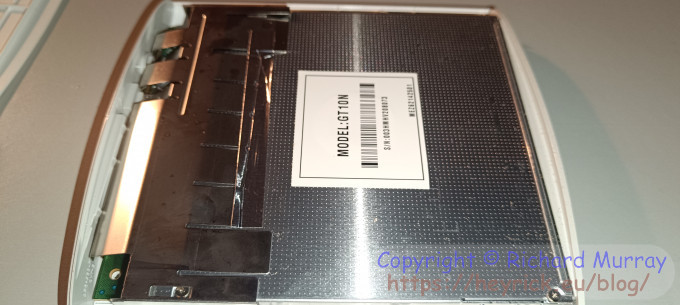 A portable USB DVD player with its cover removed. What we can see inside is... a Model GT10N DVD drive with something sticking out of the back, buried under a load of radio shielding. Let's remove that, too.
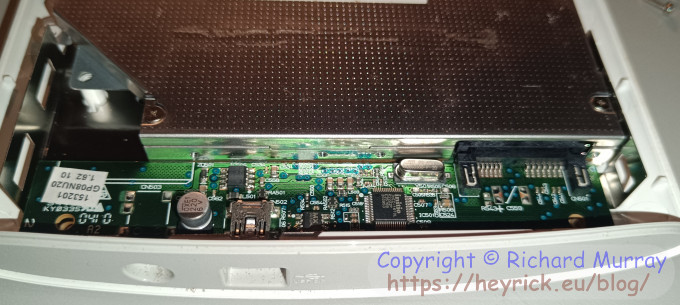 An interface board.
That, on the right there, that's a SATA interface. So what's actually inside this external DVD writer is basically a generic writer with a SATA interface that would have been found in laptops and such. Here it is stuck into a plastic box with a USB interface hanging out the back. Let's go a little closer on the interface.
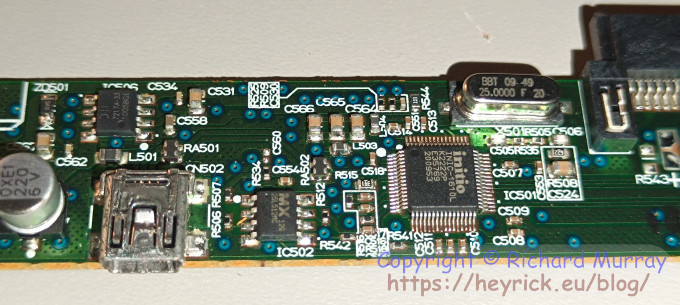 The interface board. The heart of the interface is an initio INIC-1610 USB to SATA interface. It has an integrated Turbo 8051 processor and 16KB SRAM, and it supports Mass Storage Class Bulk-Only function. It can handle 60MB/sec incoming to a 1.5G SATA interface. The datasheet implies that the input should be a 12MHz clock, but I see a 25MHz crystal. Perhaps it's ÷2 or something? To the left of that is an MX25L512 which is a CMOS serial EEPROM with 64K capacity. When the INIC-1610 powers up, it will automatically read 4K from an SPI Flash (this chip) which contains the firmware; along with the option to copy a further 12K of program code from the SPI flash if necessary. On the far left is a 7217A-33 which converts the USB 5Vish into 3.3V. Okay, now let's pop open the lid of the DVD unit itself.
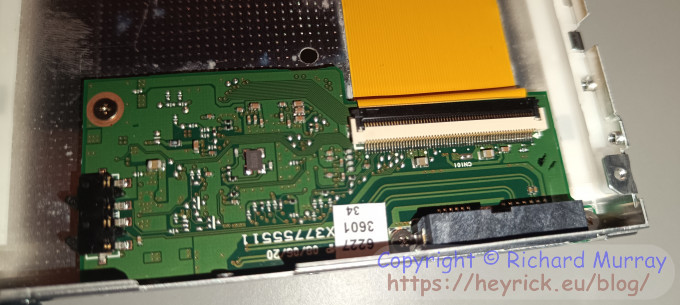 The DVD controller board. Hmmm, that's not terribly interesting. Maybe underneath?
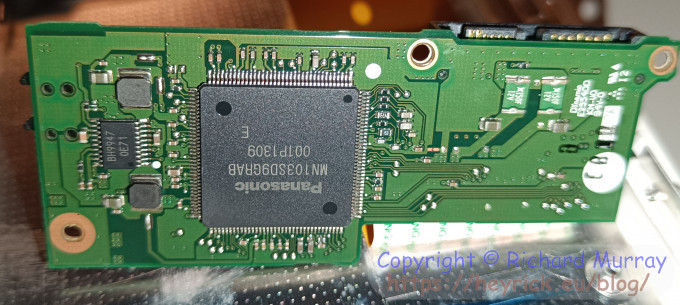 The DVD controller board, other side. Well, here's Asian cooperation for you! The LG (Korean) unit, made in China, uses a big Panasonic (Japanese) chip - the MN103SD9GRAB, which if you look online you'll get of a lot of stuff like "Hong Kong Inventory" offering to sell you several hundred of the things, but nothing that resembles a datasheet. Suffice to say this one chip is the heart of the DVD writer. SATA at one end, burny-uppy laser at the other. And a decent amount of smarts in between. I'm not going to strip down the optical unit, as it's fragile and I might still want to use this device. Here's a photo.
 The eye of Sauron.
However, in answer to the question... it's a laptop drive with a USB interface stuck to the back, placed into a fancy looking box. You're welcome. ☺
Your comments:Please note that while I check this page every so often, I am not able to control what users write; therefore I disclaim all liability for unpleasant and/or infringing and/or defamatory material. Undesired content will be removed as soon as it is noticed. By leaving a comment, you agree not to post material that is illegal or in bad taste, and you should be aware that the time and your IP address are both recorded, should it be necessary to find out who you are. Oh, and don't bother trying to inline HTML. I'm not that stupid! ☺ ADDING COMMENTS DOES NOT WORK IF READING TRANSLATED VERSIONS.
|
(Felicity? Marte? Find out!)
📺 The SIBA stories 📹
It's a simple substring match.
Last read at 09:19 on 2024/05/02.


| |||||||||||||
| Next entry - 2023/11/25 Return to top of page |
| © 2023 Rick Murray |
| Retrieved from http://heyrick.eu/blog/index.php?diary=20231123 on 2nd May 2024 |


